Pipe volume calculation: calculation principles and calculation rules in liters and cubic meters
When finding the amount of necessary fluid in the heating system, it is often necessary to solve a separate problem - to calculate the volume of the pipe with the given parameters. The computational formula itself is simple. However, in practice, to obtain an accurate result, it must be applied carefully.
We will talk about how to calculate the internal volume of an important communication system. In the article we presented, we detailed the options for performing calculations for the pipeline and heating appliances. Based on our advice, you will quickly solve the problem.
The content of the article:
Geometrical parameters of pipes
To determine the volume of the pipe, it is necessary and sufficient to know only two of its indicators: length and internal (actual) diameter. The last parameter is important not to be confused with the external size, which lead to the correct selection of fittings and connecting elements.
If the wall thickness is not known, then instead of the calculated inner diameter, DN (inner passage diameter) can be used. They are approximately equal, and the value of DN, as a rule, is indicated on the marking, which is placed on the outside of the product.
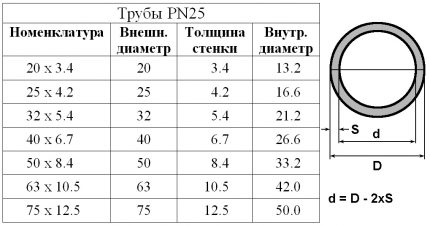
Before you try to calculate the volume of any pipe, you must not make a common mistake and bring all the parameters to a single measurement system. The fact is that length is usually expressed in meters and diameter in millimeters. The ratio of these two units is as follows: 1 m = 1000 mm.
In fact, it is possible to bring the parameters to intermediate values - centimeters or decimeters. Sometimes it’s even convenient, given that in this case the number of decimal places or, conversely, zeros will not be very large.
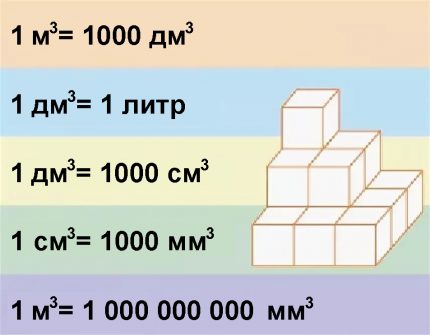
For pipes manufactured not in Russia (and not for Russia), the diameter can be expressed in inches. In this case, it is necessary to perform the recount, given that 1 ″ = 25.4 mm.
Formula for a single pipe
From the position of geometry, the pipe is a straight circular cylinder.
The volume of such an object is equal to the cross-sectional area times the length:
V = l * s
In it:
- V - volume (m3);
- l - length (m);
- S - cross-sectional area (m2).
The cross-sectional area of a pipe in the form of a circle with a known diameter is calculated by the formula:
S = π * d2 / 4
Here:
- π = 3.1415926;
- d - circle diameter (m).
The final formula for the volume of the pipe with a known inner diameter and length will be as follows:
V = π * l * d2 / 4
If the unit of measurement for the length and diameter of the pipe is a different value (dm, cm or mm), then the volume will be expressed in dm3, cm3 or mm3 respectively.
Also, I wanted to show you a simple way to measure the outer diameter of the pipe (D) without caliper. D = L / πwhere L - circumference:
For the correct calculation of the volume of pipes, it is necessary to substitute two parameters into a simple formula: length and inner diameter. How accurately they will be measured or calculated, the result will be so accurate.
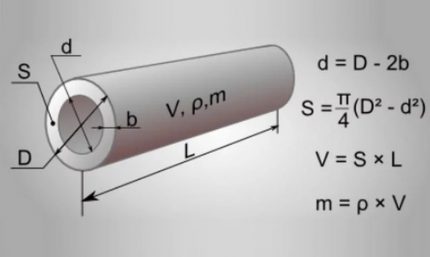
Applied examples of calculations
Significant help in analyzing the principles of calculations and the sequence of actions when performing calculations will be provided by specific examples, which should be familiar to interested visitors.
Task # 1 - calculation of the volume of the required coolant
For a country house of temporary residence, you need to calculate the amount of purchased propylene glycol - coolant not hardening at temperatures down to -30 ° C. The heating system consists of a furnace with a 60 liter jacket, four aluminum batteries of 8 sections each and 90 meters of PN25 pipe (20 x 3.4).
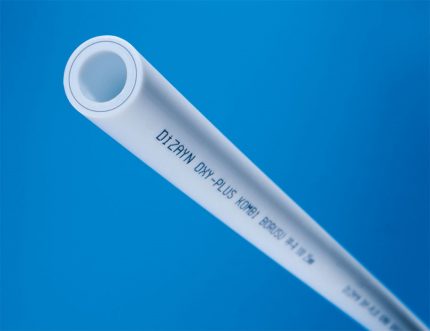
The volume of fluid in the pipe must be calculated in liters. For this, a decimeter should be taken as a unit of measurement. The transition formulas from standard lengths are as follows: 1 m = 10 dm and 1 mm = 0.01 dm.
The volume of the boiler shirt is known. V1 = 60 liters
In the passport of the aluminum radiator Elegance EL 500 it is indicated that the volume of one section is 0.36 liters. Then V2 = 4 * 8 * 0.36 = 11.5 l.
We calculate the total volume of the pipes. Their inner diameter d = 20 - 2 * 3.4 = 13.2 mm = 0.132 dm. Length l = 90 m = 900 dm. Hence:
V3 = π * l * d2 / 4 = 3.1415926 * 900 * 0.132 * 0.132 / 4 = 12.3 dm3 = 12.3 l.
Thus, now you can find the total volume:
V = V1 + V2 + V3 = 60 + 11.5 + 12.3 = 83.8 l.
The percentage of the amount of fluid in the pipes in relation to the entire system is only 15%. But if the length of communications is large or the system is used “Water floor heating”, then the contribution of pipes to the total volume increases significantly.
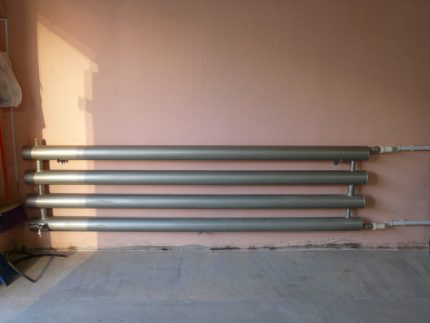
Task # 2 - calculation of the volume of a homemade radiator
Let's figure out how to calculate a classic home-made heating radiator from four horizontal pipes 2 m long. First you need to find the cross-sectional area. You can measure the outer diameter from the end of the product.
Let it be 114 mm. Using the table of standard parameters steel pipes, we find the wall thickness characteristic of this size - 4.5 mm.
Calculate the inner diameter:
d = 114 - 2 * 4.5 = 105 mm.
Define the cross-sectional area:
S = π * d2 / 4 = 8659 mm2.
The total length of all fragments is 8 m (8000 mm). Find the volume:
V = l * S = 8000 * 8659 = 69272000 mm3.
The volume of the vertical connecting tubes can be calculated in a similar way. But this value can also be neglected, since it will be less than 0.1% of the total volume of the heating radiator.
The resulting value is uninformative, so we will translate it in liters. Since 1 dm = 100 mm, then 1 dm3 = 100 * 100 * 100 = 1000000 = 106 mm3.
therefore V = 69272000 / 106 = 69.3 dm3 = 69.3 l.
Large batteries or heating systems (which are installed, for example, on farms) require significant amounts of coolant.
Therefore, since it will be necessary to calculate the volume of pipes in m3, then all dimensions before substituting them in the formula will need to be immediately converted to meters.
Task # 3 - calculation of the required length of PP pipes
You can get the value of the fragment length using an ordinary ruler or tape measure. Slight bending and sagging of the polymer pipes can be neglected, as they will not lead to a serious final error.
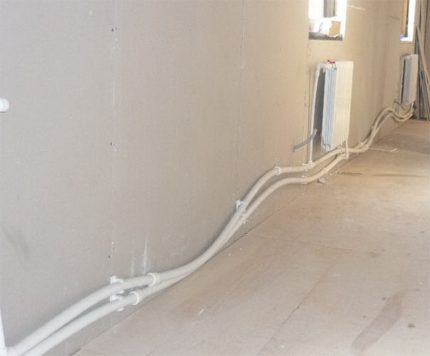
To maintain accuracy, it is much more important to correctly determine the beginning and end of a fragment:
- When connecting the pipe to the riser, measure the length from the beginning of the horizontal fragment. No need to grab the adjacent part of the riser, as this will lead to a double count of the same volume.
- At the entrance to the battery, you need to measure the length to its tubes capturing the taps. They are not taken into account when determining the radiator volume according to its passport data.
- At the entrance to the boiler, you need to measure from the shirt, taking into account the length of the outgoing tubes.
Rounding can be measured in a simplified way - assume that they pass at right angles. Such a method is admissible, since their total contribution to the length of the pipes is insignificant.
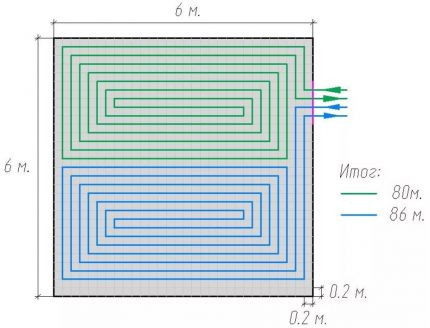
The volume of the warm floor is calculated by the meter of installed pipes.
If data on the length or pattern is not available, but the step between the tubes is known, then the calculation can be carried out according to the following approximate formula (regardless of the installation method):
l = (n - k) * (m - k) / k
Here:
- n - the length of the warm floor;
- m - the width of the warm floor;
- k - step between the tubes;
- l - the total length of the tubes.
Despite the small cross section of the pipes that are used for water floor heating, their total length leads to a significant amount of enclosed coolant.
So, to provide a system similar to that in the above figure (length - 160 m, outer diameter - 20 mm), 26 liters of liquid will be needed.
Obtaining the result by an experimental method
In practice, problematic situations arise when the hydraulic system has a complex structure or some of its fragments are laid in a secretive way. In this case, it becomes impossible to determine the geometry of its parts and calculate the total volume. Then the only way out is to conduct an experiment.
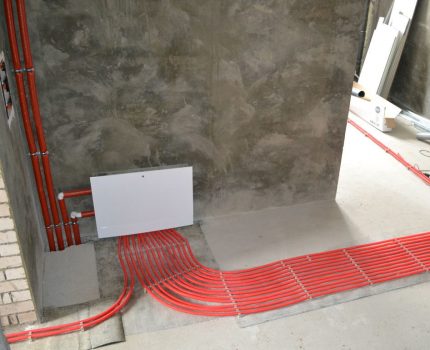
It is necessary to drain all the liquid, take some measuring container (for example, a bucket) and fill the system to the desired level. Filling occurs through the highest point: open expansion tank or upper trigger valve. At the same time, all other valves must be open to avoid the formation of air jams.
If the pump moves the water along the circuit, then let it run for an hour or two without heating the coolant. This will help drive out residual air. After this, add fluid to the circuit once more.
This method can also be used for individual parts of the heating circuit, for example, underfloor heating. To do this, disconnect it from the system and “shed” it in the same way.
findings
Despite the fact that in the network we are offered a huge selection of software products for performing calculations on the coolant displacement, there are guest tables for determining the internal volume of pipes, you need to know the principles of “manual” calculations.
They are necessary for those who independently engage in the construction and repair of communications, and those who use the services of design and construction organizations.Useful information will help determine the material consumption before the system device, accurately calculate the estimate and get an idea of the upcoming operational payments.
Want to talk about how you calculated the volume of coolant for an autonomous heating system in a country house or in a country house? Do you have information that may be useful to site visitors? Please write comments, post photos on the topic of the article, ask questions in the block below.

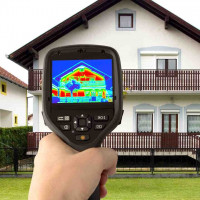 Thermotechnical calculation of a building: specifics and formulas for performing calculations + practical examples
Thermotechnical calculation of a building: specifics and formulas for performing calculations + practical examples  Calculation of air heating: basic principles + calculation example
Calculation of air heating: basic principles + calculation example  Calculation of water heating: formulas, rules, examples of implementation
Calculation of water heating: formulas, rules, examples of implementation  Calculation of the heating system of a private house: rules and examples of calculation
Calculation of the heating system of a private house: rules and examples of calculation 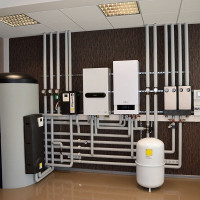 Thermal calculation of a heating system: how to correctly calculate the load on a system
Thermal calculation of a heating system: how to correctly calculate the load on a system 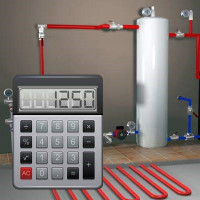 The average gas consumption for heating a house is 150 m²: an example of calculations and an overview of thermal formulas
The average gas consumption for heating a house is 150 m²: an example of calculations and an overview of thermal formulas  How much does it cost to connect gas to a private house: the price of organizing gas supply
How much does it cost to connect gas to a private house: the price of organizing gas supply  The best washing machines with dryer: model rating and customer tips
The best washing machines with dryer: model rating and customer tips  What is the color temperature of light and the nuances of choosing the temperature of the lamps to suit your needs
What is the color temperature of light and the nuances of choosing the temperature of the lamps to suit your needs  Replacement of a geyser in an apartment: replacement paperwork + basic norms and requirements
Replacement of a geyser in an apartment: replacement paperwork + basic norms and requirements